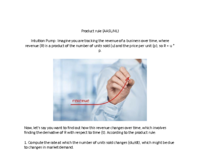Product rule (AASL/HL)
Keywords
| Product rule | 積の法則 | 곱의 법칙 | 乘积规则 |
| Differential calculus | 微分計算 | 미분 계산 | 微分学 |
| Derivative | 導関数 | 도함수 | 导数 |
| Functions | 関数 | 함수 | 函数 |
| Differentiating products | 積の微分 | 곱의 미분 | 乘积的微分 |
| Factual Inquiry Questions | Conceptual Inquiry Questions | Debatable Inquiry Questions |
| 1. What is the product rule in differential calculus? | 1. Why is the product rule necessary for differentiating products of functions, as opposed to simply multiplying their individual derivatives? | 1. Is the product rule more foundational to calculus than the quotient rule, given its applications and the way it's taught? |
| 2. How is the product rule applied to find the derivative of the product of two functions? | 2. How does the product rule facilitate the understanding and computation of derivatives in more complex functions? | 2. Can the conceptual understanding of the product rule be extended to enhance approaches to teaching other rules of differentiation? |
| 3. How do advancements in symbolic computation impact the practical importance of manually applying the product rule in calculus? |
Mini-Investigation: The Tale of Two Derivatives
Chapter 1: The Classic Approach We have before us a magical expression y = (x + 3)(x + 2). The ancient wizards derived this using the Product Rule. But what if the Product Rule had not yet been discovered? 1. If you were a mathemagician without the Product Rule at your disposal, how would you find the derivative of y = (x + 3)(x + 2)? 2. Perform this ancient technique to calculate dy/dx. Show your process step by step.
Chapter 2: The Product Rule Revealed Now, let's use the Product Rule, a spell that combines the powers of u(x) and v(x) to find the derivative of their product. 1. Apply the Product Rule to find the derivative of y = (x + 3)(x + 2). Record each incantation and compare it to your previous method. 2. Which method was quicker? Describe the advantages of using the Product Rule over the classic approach.
Chapter 3: The Duel of Derivatives It's time to test your newfound skills in a friendly duel against the time-tested classic method. 1. Using both methods, find the derivative of a new spell z = (x+1)(2x + 4)^2). Which method leads you to the answer more efficiently? 2. Reflect on your findings. How does each method's result help us understand the behavior of the spell z as x changes?
Chapter 4: Beyond the Textbook The real world is filled with complexities far beyond the boundaries of a textbook. Sometimes, the Product Rule is a necessity, not a choice. 1. Can you think of a real-world scenario where the Product Rule would be essential in finding the rate of change? 2. Propose a situation where the classic method might be more insightful or useful, despite its lengthier process. ## Epilogue: The Wisdom Gained As the stars of knowledge align, let's reflect on the lessons learned from our investigative journey. 1. Discuss how the Product Rule and the classic method each contribute to your understanding of calculus.
Part 2
Bonus - Geometric interpretation of the product rule
Question 1 If and , what is the derivative of ?
Question 2 Given and , what is the derivative of ?
Question 3 If and , what is the derivative of ?
Question 4 Consider and . What is the derivative of the product ?
Question 5 If and , what is the derivative of ?

